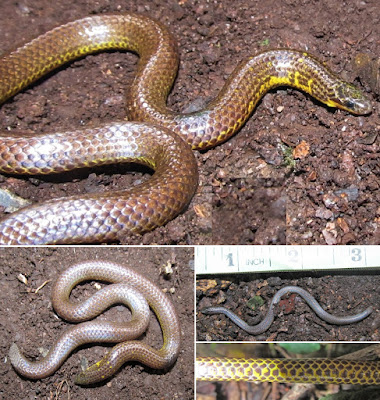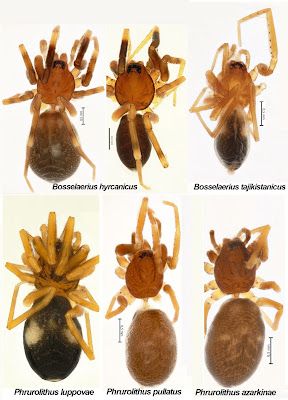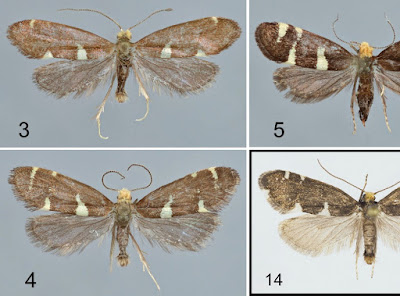[Most Recent Entries] [Calendar View]
Monday, March 30th, 2020
| Time | Event | ||||
| 6:05a | [Herpetology • 2020] Uropeltis rajendrani • A New Species of Shieldtail Snake (Squamata: Uropeltidae) from Kolli Hill complex, southern Eastern Ghats, peninsular India
Abstract We describe a new species of shieldtail (uropeltid) snake, Uropeltis rajendrani sp. nov., from the Kolli Hill complex of the southern Eastern Ghats in Tamil Nadu, India. The new species belongs to the U. ceylanica group and is differentiated from related species in having 16–17:16–17:15–16 dorsal scale rows; 145–158 ventral scales; 8–11 pairs of subcaudals; dorsum uniform brown, anteriorly powdered with yellow mottling; venter brown, scales outlined with yellow. This endemic species with a restricted range is known only from atop Kolli Hill complex, inhabiting higher elevation (> 900m) evergreen forests, where it is the only known member of this genus. Keywords: Allopatric species, endemism, isolated massif, Uropeltis rajendrani sp. nov., Western Ghats.
Uropeltis rajendrani sp. nov. Uropeltis cf. ceylanica (nec Cuvier, 1829) – Ganesh & Arumugam 2016 Etymology: Named in honour of Dr. Maria Viswasam Rajendran (2 Nov 1916–6 Aug 1993), ‘MVR’ for short, for his exhaustive studies on shieldtail snakes in Tamil Nadu, next only to Richard Henry Beddome and Frank Wall. Not only was he a professor of zoology at the St. Joseph’s College Palayamkottai (Tirunelveli, Tamil Nadu) but also the director of the Madras (now Chennai) Snake Park (Chennai, Tamil Nadu) during the early 1980s. Common name: Rajendran’s Shieldtail Snake. Type locality: Bodhamalai Hills near Salem and Namakkal District border, overlooking Panamarathupatti Town (...; 1,070m), Tamil Nadu State, peninsular India. Diagnosis: A species of Uropeltis from the Kolli Hill complex, characterized by having the following combination of characters: (1) caudal shield truncate, with a distinct thickened circumscribed concave disc; (2) part of rostral visible from above not distinctly longer than its distance from frontal; (3) rostral scale partially separating nasal scales; (4) snout obtusely rounded; (5) eye diameter 3/4th that of ocular shield; (6) dorsal scale rows 16–17:16–17:15–16; (7) ventral scales 145–158; (8) subcaudal scales 8–11 pairs; (9) dorsum deep brown, unpatterned, anteriorly with a few yellow speckles; (10) venter yellow, each scale edged with brown. S.R. Ganesh and N.S. Achyuthan. 2020. A New Species of Shieldtail Snake (Reptilia: Squamata: Uropeltidae) from Kolli Hill complex, southern Eastern Ghats, peninsular India. Journal of Threatened Taxa. 12(4); 15436–15442. DOI: 10.11609/jott.5680.12.4.15436-15442 | ||||
| 6:50a | [Arachnida • 2020] A Survey of Phrurolithidae (Araneae) in southern Caucasus, Iran and Central Asia
Abstract The spider family Phrurolithidae is revised in Azerbaijan, Iran and Tajikistan. The new genus Bosselaerius gen. n. is described to encompass three species: B. hyrcanicus sp. n. (type species, ♂ ♀, Azerbaijan, Iran), B. tajikistanicus sp. n. (♀, Tajikistan) and B. daoxianensis (Yin, Peng, Gong & Kim, 1997) comb. n. (♂, China). Furthermore, a new species of Phrurolithus C.L. Koch, 1839, namely P. azarkinae sp. n. (♂ ♀, Azerbaijan, Iran) is described, a redescription is provided for the poorly-known P. luppovae Spassky, 1941 (♂, Tajikistan), with its female being described for the first time, and P. pullatus Kulczyński, 1897 is recorded in Iran for the first time, representing the easternmost recorded locality for this species. Finally, 27 species of Chinese Phrurolithidae currently classified in Phrurolithus are transferred to Otacilia Thorell, 1897 on the basis of somatic characters and the morphology of the copulatory organs. Distributions of all treated species are mapped. Keywords: Araneae, Aranei, spider, new genus, new species, new combination, Otacilia Alireza Zamani and Yuri M. Marusik. 2020. A Survey of Phrurolithidae (Arachnida: Araneae) in southern Caucasus, Iran and Central Asia. Zootaxa. 4758(2); 311–329. DOI: 10.11646/zootaxa.4758.2.6 | ||||
| 7:30a | [Entomology • 2020] Incurvaria pirinella • A New Species of the vetulella species-group (Lepidoptera, Incurvariidae) from Bulgaria, with release of DNA Barcodes for European Species of Incurvaria
Abstract Incurvaria pirinella Junnilainen, Kaitila & Mutanen, sp. nov. is described from Bulgaria based on specimens collected by netting and artificial light from several low-elevation localities in Bulgaria. The species is morphologically and genetically most similar to I. triglavensis Hauder, 1912. Differences between these two species are present in external appearance and genitalia of both sexes. Additionally, I. pirinella shows a distance of 4.74% to its nearest neighbour I. triglavensis in the standard DNA barcoding marker (COI-5P). We provide preliminary observations of phylogenetic affinities of European Incurvaria and briefly discuss habitat preferences of some species. All species have distinct barcodes with minimum K2P divergences between species averaging 7.05% (range 1.2–12.8%). A world checklist of Incurvaria Haworth, 1828 is provided and DNA barcodes for all European species are here released. Finally, we document morphological variation in male genitalia within I. triglavensis Hauder, 1912. Incurvaria pirinella Junnilainen, Kaitila & Mutanen, sp. nov. Etymology: The name of the new species is derived from the Pirin mountain range, where the new species is widely distributed. Diagnosis: Considering similar forewing ground colour and markings, Incurvaria pirinella (Figs 3–5) is externally closest to I. circulella (Fig. 14), but is easy to separate from it by the dark grey-brown fringe and distinct white spot in the forewing fringe present in I. circulella. Incurvaria pirinella is also widely allopatric as I. circulella occurs only in northern latitudes in Europe, e.g. the northern part of Sweden and Finland. Although I. triglavensis is rather variable externally, it is always easy to separate from I. pirinella based on its relatively narrow forewing shape, paler ground colour and differences in forewing markings (Figs 6–11); see details in Suppl. material 2. Incurvaria pirinella is easy to separate externally from Scandinavian I. vetulella (Figs 12–13) by a white narrow dorsal spot situated 2/5 from base and extending more than halfway across the forewing in I. pirinella. North European I. vetulella also typically have a distinctly broader dorsal spot, sparser forewing scaling and usually a pale medial area in the fringe, which is always absent in I. pirinella. ... Distribution: Known from four different localities in the south-west corner of Bulgaria around the Struma river valley and its adjacent regions, which all belong to the Blagoevgrad district and the Pirin mountain range. The elevational range is wide: 200–1200 m, at least. Jari Junnilainen, Peter Buchner, Jari-Pekka Kaitila and Marko Mutanen. 2020. Incurvaria pirinella sp. nov., A New Species of the vetulella species-group (Lepidoptera, Incurvariidae) from Bulgaria, with release of DNA Barcodes for European Species of Incurvaria. Nota Lepidopterologica. 42(1): 81-100. DOI: 10.3897/nl.42.13026 |
| << Previous Day |
2020/03/30 [Calendar] |
Next Day >> |















